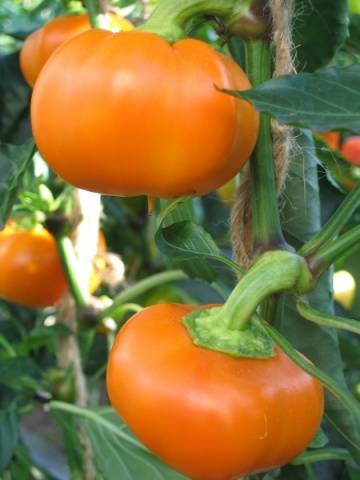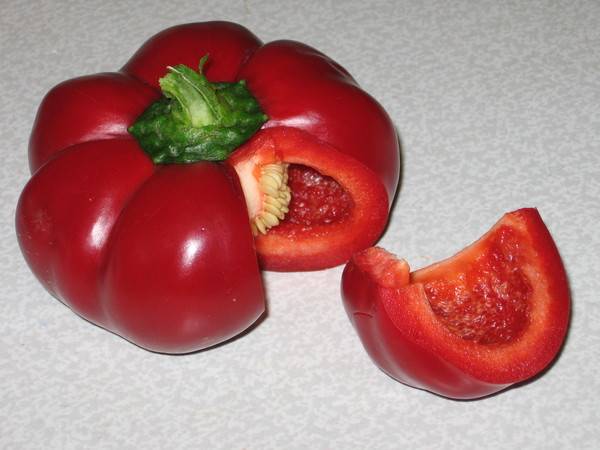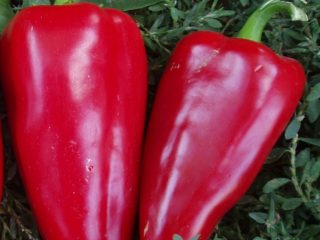Content
Today, breeders have produced an abundance of sweet pepper varieties. To get a bountiful harvest of this vegetable in your garden, it is important not to make the wrong choice of variety. The gardener will need to take into account the characteristics of the crop and follow recommendations for growing fruits.
Common varieties of peppers
In specialized stores you can find seeds of various varieties. They bear fruit in the form of a cube, cone or ball. The colors of peppers also vary: they are red, orange, green and yellow. White and purple vegetables are not so common.
Varieties also differ in terms of ripening. They can be divided into three groups:
- Early ripening. They ripen quickly and bring a bountiful harvest within 80 days from the moment the seeds are sown. They are planted in the northern regions of the country, where summers are often short and cool.
- Mid-season. Such varieties are suitable for the middle zone, where they can be successfully grown in a greenhouse. It takes about 120 days from sowing the seeds to the first fruits. In the south they are planted directly in open ground.
- Late ripening. It will take about 140 days for the peppers to ripen. These varieties are suitable for growing in greenhouse conditions or in the southern regions.
When choosing, pay attention to the shape. Here it is worth taking into account how the fruits will be used. For salads, the shape of the pepper generally does not matter at all. And here for stuffing Often they take varieties with regular outlines.
Purpose of round peppers and common varieties
Small round peppers are ideal for canning in jars; what is the variety called and where should it be grown? You can read further. Among spherical vegetables there are not so few large varieties.
Kolobok
This is one of the most popular varieties among gardeners. The weight of one pepper is more than 150 g. It is distinguished by thick walls and pericarp. It is so loved by gardeners due to its resistance to rot, mold and wilt.
“Koloboks” ripen quickly and bear fruit abundantly. The peppers are round in shape and have smooth skin. The pulp is juicy, the vegetables have a pleasant aroma. They are consumed fresh and also used for winter preparations.
Helios
One of the early varieties, distinguished by round-shaped fruits. It takes 110-120 days from seed germination to technical ripeness. Biological ripeness is achieved after 140-150 days. The plant is small in height - about 35 cm. The fruit weighs from 100 to 150 g, the walls are 6-8 mm, the skin is smooth. As it ripens, it acquires a yellow color.
It is recommended to sow the seeds for seedlings first. High-yielding variety that resists wilting. Peppers retain their marketable appearance and are suitable for both direct consumption and canning.
Scythian
Also applies to early peppers. 108-120 days pass before the onset of technical ripeness, biological ripeness occurs later - after 140-155 days. The plant is compact and low - about 35 cm. The fruits are round, weight varies from 150 to 220 g. At first they are light green in color, then they become bright red. They have smooth skin and tender flesh. The walls reach 8-9 mm in thickness.
The Golden Fleece
This variety produces round, slightly flattened peppers. It is classified as mid-season; it takes 115-125 days to reach technical ripeness. Biological ripeness occurs within 150 days. The height of the bush is about 50 cm, the foliage is dense. The weight of one vegetable reaches 180-220 g, fruits with thick walls are 8.5-10 mm.
When biological ripeness is reached, peppers of the Golden Fleece variety have a yellow-orange color. First, it is advised to sow seeds for seedlings. Has excellent taste. Resists verticillium wilt.
Sultan
This mid-season sweet pepper forms a tall bush of 45-60 cm with dense foliage. The fruits are round, with slight ribbing, large in size, weight in the range of 100-150 g. When they reach biological ripeness, which occurs in 158-165 days, they acquire a dark red color. Walls 8-10 mm.
The fruits have excellent taste. Seeds are planted through seedlings; sowing in cassettes is common. The variety resists wilting. Peppers can be used fresh in the kitchen or canned for the winter.
Maria F1
A mid-season hybrid (as the name indicates), producing abundant harvests. The bush is quite tall, the stem grows up to 85 cm. The peppers are round, slightly flattened in shape with a ribbed surface. When they reach biological ripeness, they acquire a rich red color. The weight of one fruit is 100 g, the walls are 6-7 mm.
Novogoshary
The variety forms a standard bush up to 60 cm high. The fruits grow with thick walls (from 8 to 11 mm), the pulp is juicy. The skin is red. If you follow the recommendations for growing this variety, you can get peppers weighing up to 140 g. Fruiting in these plants continues for one and a half months.
Interesting varieties of Dutch selection
The varieties and hybrids obtained by Dutch breeders have excellent characteristics. Below we will name some of them.
Topepo
In appearance in the photo, this pepper strongly resembles a tomato. It has a bright red color, a round shape and very thick walls - up to one and a half centimeters. The pulp is juicy and very tasty. The weight of one fruit reaches 100-150 g. At the stage of technical ripeness, green in color, the harvest can be harvested at this stage of growth.
The fruits are used for stuffing, cut into rings for salads or main courses. Thick-walled peppers retain their shape well, so they can be stored for a long time. Also suitable for canning. It has high productivity.
Tepin
A variety of hot pepper with a round shape and miniature size. It has a pronounced pungency that quickly fades away.
Alma paprika
After planting in the soil, the fruits ripen within 70 days. The origin of the variety comes from Hungary. One of the sweet peppers, has a slight heat (the name of the variety includes the word “paprika”). Suitable for drying and subsequent grinding to prepare spices. Can be eaten directly.
The diameter of the average round fruit is 5 cm, the bush grows up to 45 cm. Flowering occurs in mid-summer. The peppers are thick-walled and turn from cream to orange or red as they ripen.
Getting to know the Gogoshary variety
Gogoshary is one of the varieties of sweet peppers that bears round fruits. When it reaches technical ripeness, it is green, and later becomes yellow or red.
This variety is an early ripening variety; the seedlings outcompete other varieties of sweet pepper. The fruits grow large, juicy, with thick walls. They are very convenient to use for stuffing.
Growing these vegetables consists of the following steps.
- Seed preparation. To disinfect them, they are treated with a solution of potassium permanganate.
- Soil preparation. The soil can be poured into a box and treated with steam by holding it over boiling water.
- Sowing seeds for seedlings. In terms of timing, it is better to do this closer to the end of February.
- Transplanting seedlings into the ground towards the end of May. It is worth noting that these plants should not be buried.
- Further care includes regular watering, fertilizing, and loosening the soil.
- When mid-August passes, the fruits will reach biological ripeness. They will turn from green to yellow or red. Gogoshary peppers often have redness.
Gogoshary is a high-yielding variety. If weather conditions worsen, unripe fruits can be removed and placed in a dry cloth bag. If you leave them in a dark place for a couple of weeks, they will begin to acquire their final shade, as in the photo.
Selecting seeds: what biological characteristics to pay attention to
The developmental characteristics of plants directly affect how much time and effort it takes to care for them. Depending on this, the cost of peppers will change. There are two main aspects.
- Maximum plant height. This indicator directly determines how much effort will be required to grow the plant. In different varieties, the stem can grow from 30 to 170 cm. When choosing tall plants, it is worth considering that they require tying, which means additional devices and effort. The stem itself is herbaceous, gradually it begins to become woody at the base. Separate flowers are formed in the branching zones.
- Storage period. When purchasing seeds, you should find out how long the crop can last without losing its original characteristics.
Varietal characteristics also affect other aspects. It is important to clarify whether a particular bell pepper is resistant to diseases and pest attacks. Each variety has its own yield.
Differences in growing sweet peppers
Pepper is a heat-loving crop. Therefore, if in the southern regions the bushes can be safely planted in open ground, then in the northern regions it will be possible to obtain a bountiful harvest only in a greenhouse.
Unlike other crops, pepper has a longer growing season. This property explains that peppers are grown through seedlings. Seeds are sown in early February. To do this, use boxes with fertile soil.
Many gardeners prefer to buy seeds of early ripening varieties. When grown under cover, the fruits reach technical ripeness within 100 days from the moment of seedling formation.
Peppers are quite picky about temperature:
- for seed germination the best temperature is 25-27 degrees;
- the optimal temperature regime for plant development is 20-23 degrees;
- if the readings drop to 13 degrees, seedlings and already mature plants stop growing.
Peppers need not only warmth, but also lighting.If you plant young shoots in a shaded area, they will stretch out and shed their flowers and ovaries. The bed for peppers should be allocated in a well-lit place, sheltered from strong winds.
Conditions such as moisture and fertile soil are also important for peppers. The soil should be light and loose, well moistened, with neutral acidity. Lack of water significantly affects the condition of plants and the size of fruits.
If you follow agricultural techniques, you can grow a rich harvest of peppers on your plot. This culture is demanding of moisture, light and heat. The variety must be selected taking into account the climatic characteristics of your region. In the southern regions, peppers can be grown in an open garden bed, while in the northern and central regions it is preferable to plant them in a greenhouse. Round fruits are perfect for stuffing and canning.




















